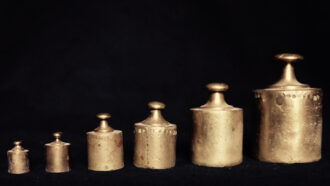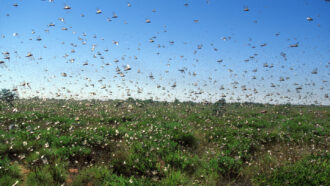Search Results

Climate Change Spikes Baseball Homers
Baseball fans love numbers and explaining every nuance of baseball statistics. In this Guide, students will learn how climate change is boosting home runs and study the physics behind the increase in homers.
Applying the ideal gas law
Summary: Students will review the ideal gas law and use a simulation to explain the assumptions made in a recent study about how climate change is impacting baseball.
Learning Outcomes: Exploration of the cause and effect of manipulating conditions of a gas using a simulation, identifying relationships of variables using a mathematical equation and application of theoretical concepts to real-world examples.
Confounding Life and Science Research
In this quick activity, students will discuss confounding factors in their own lives and in scientific research to determine why it is important to identify and control for those factors.
Learning Outcomes: Reviewing confounding factors and learning why it is important to identify them in science.
How heat and home runs are connected
Students will answer questions about the online Science News article “Baseball’s home run boom is due, in part, to climate change,” which explores how increases in temperatures boost home run numbers. A version of the article, “Climate change spikes baseball homers,” appears in the May 6, 2023 & May 20, 2023 print issue of Science News.

This Dwarf Planet Hosts an Odd Ring
In science, the exceptions offer researchers a chance to think differently about a concept they thought they understood. In this Guide, students will learn how astronomers use a concept called the Roche limit and how a ring around a dwarf planet does not follow the Roche limit rules.
Defining and defying Roche limits
Students will review force diagrams and gravitational force and discuss planetary ring and moon formation using the concept of the Roche limit.
Learning Outcomes: Applying gravitational forces and interactions in space to understand ring and moon formation.
Vibration check
Most of us drive across bridges every day and never question their structural integrity. We trust that the bridge will stand. In this activity, students will study a famous bridge collapse and consider how it could have been prevented. They also will learn how engineers are testing whether crowdsourced cell phone data could be used to determine when bridges need repairs. Using simulated data of bridge vibration frequencies, students will identify whether an imaginary bridge might be unstable. Students have the option of creating model bridges and testing their structural integrity.

The Metric System Has Gained New Prefixes
In this guide, students will learn about new measurement prefixes, work with those prefixes in metric conversions and create their own units of measure.
Measuring up with metric prefixes
Students will review prefixes and their meanings, learn about the metric system’s newest prefixes and apply the definitions in metric conversions. Learning Outcomes: Proportion and scale, measurement and dimensional analysis, a deeper understanding of the metric prefixes.
Form fits function in extreme environments
From buildings to machines to household objects — and even in the natural world — the structure of something relates to its function. Sea urchin skeletons, for example, have a recurring geometric design called a Voronoi pattern that also shows up in honeycombs and dragonfly wings. The pattern probably strengthens the skeleton and could inspire the creation of strong, lightweight materials. In this activity, students will explore aspects of structure and function in everyday objects before applying the same concepts to the natural patterns found in sea urchin skeletons. Inspired by the sea urchin, students can use an engineering design process to brainstorm solutions to real-world problems.

Insect Swarms Might Electrify the Sky
Large swarms of insects could produce as much electricity as a storm cloud. In this guide, students will explore how insect-induced static electricity might affect the atmosphere, review the concepts of electric charge and electrostatic force, and apply those concepts to their own experiences and the biological phenomenon of insect swarms. In a quick activity, students will create a poem or song about serendipity in science.
Sticking to static electricity with Coulomb’s law
Students will use their experiences of static electricity to learn about electric charge and electrostatic force, then apply the concepts to a biological phenomenon. Learning Outcomes: Reinforcement of Coulomb’s Law with interdisciplinary examples.